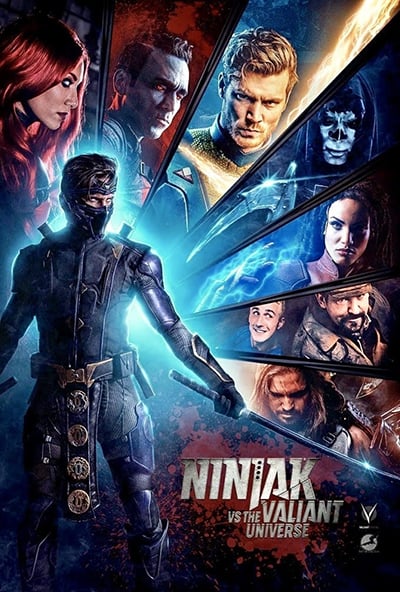How to Break into Movie and T.V. Work with Drones: An Interview with Ryan Deremo, President of SkyFly Cinematics
BY Zacc Dukowitz
13 June 2018Ryan Deremo is a Drone Pilot Ground School alum who’s found success doing drone work for television and movies in Los Angeles with his UAV services company SkyFly Cinematics.
For a while now Ryan has been filling us in on the growth of his company and his growing list of impressive projects. We wanted to sit down and learn more about how he first found drone work in the entertainment industry, and what that work looks like today.
Check out this video Ryan made during 4th of July celebrations in Los Angeles.
—
Begin Interview
You’ve done a lot of drone work in the film industry. How did you get your first job, and how have you grown your career in aerial cinematography?
The importance of networking can’t be understated.
To get my first job, a fellow drone pilot I know recommended me to the director for a pro bono gig. It turned out to be aerial videography for a Stevie Kalinich music video in Burbank, California.
Not only did I shoot the aerial shots, but the director ended up using me as an extra in several of the scenes. During down time on set, I found myself chatting with an older gentleman who turned out to be Stephen Kalinich himself.
Kalinich is a long-time collaborator and friend of the Beach Boys, and co-wrote several of their famous songs—so I had my brush with one of the greatest spoken word artists of all time, and made more valuable contacts at the same time!
Here is the Stevie Kalinich music video Ryan worked on
As for the second part of your question, I believe the key to getting a potential client’s attention and being selected for opportunities like this is having a solid demo video cut together.
Another tip for growing your client base is to invest in a quality business card. In this profession, image is everything. Integrate a couple of your own aerial still photos on the front and back of your card, order a lot of them, and keep them on you at all times, because you never know who you may meet.


A shot of Ryan’s business card
I’ve actually met and ended up working with quite a few Uber drivers who are either friends with people in the film industry or work in the industry themselves. A consistent sales effort is important—this includes cold calls, blind emails, networking, and pro-bono work to get to know people and find new work.
You have to pitch yourself and your services. Let people you talk to know you’re on the cutting edge when it comes to your equipment, that you are commercially licensed under the FAA’s Part 107 rules, and add a few words about what you have specifically accomplished in the industry. The more people know about your operations and how you differentiate yourself from the competition, the more likely a potential client will use you for a project.
Once you gain trust by proving yourself on set, the word will spread naturally, and clients will start calling you instead of the other way around.
What’s something about working in the film industry as a pilot that you’ve found surprising, and didn’t know before you started the work?
How hard it is to run your own company!
Getting the commercial license, insurance, knowledge of airspace, and proper training can take you only so far. Unless you’re ready to file quarterly taxes, give out employee tax paperwork, and stay up to date with the latest business requirements, you may want to think about working for a company that needs drone operators instead of starting one yourself.
Hollywood can be a cutthroat industry with a lot of people trying to take advantage of what you have to offer. Don’t let anyone infringe on your skillset and time. It’s important to stay adamant yet realistic about your clients’ expectations, along with your own.
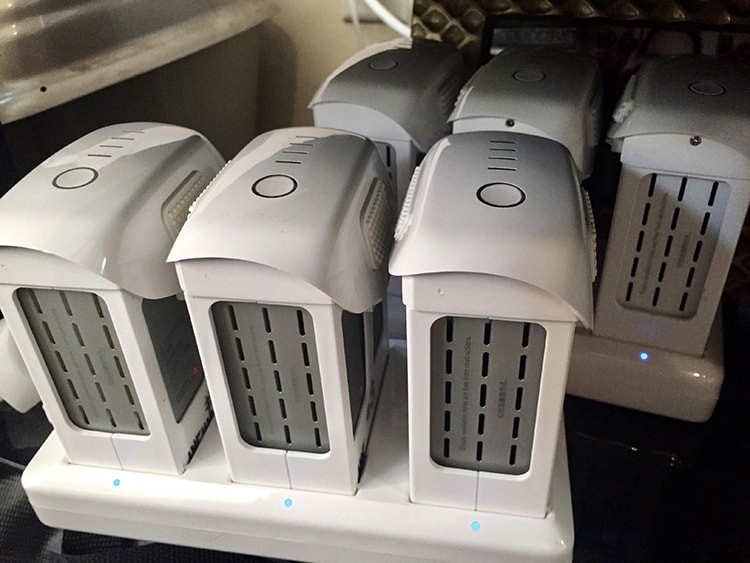

Ryan’s charging stations—just one piece of the puzzle that is running your own drone business
To those trying to break into doing aerial cinematography for movies, what advice can you give them?
Pro-bono work is something that will almost always help you get hired down the road.
People want to see what you’re made of, and that you can accomplish what they need. Based on my experience, after a free shoot you will be paid on the next film or project. One tip—with pro bono work, I always let my clients know what the work typically would have cost, depending on their need and budget.
[Derrick Ward used the same pro bono approach to grow his drone business to the point where he can now charge up to $250 an hour—read his story here.]
If you don’t think you can run a company entirely by yourself, it may be a good idea to take some film classes and join a film union like I.A.T.S.E. You have to keep swimming upstream no matter the setbacks, as UAV Coach’s Alan Perlman once told me.
Even if you feel your workload is stagnant or you hit a roadblock—if you feel that you aren’t going to make it, then that’s what will happen. Staying positive isn’t always easy, so you have to keep your head up. Make sure that you showcase your work on as many social media outlets as you can. Take classes on UAV Coach or elsewhere, research on YouTube, take a business class at a local university, and keep it going!
Interested in getting into movie and T.V. work with drones? We’re partnered with Stewart and Alina over at Drone Film Guide where they teach drone pilots a 5-step framework for creating stunning aerial cinematography. As a partner, we’re able to offer our readers a discount on their 8-hour online course, Drone Cinematography Masterclass 3.0, From Drone Owner To Aerial Cinematographer.
Tell us about your background. How did you first get involved with aerial cinematography?
Prior to owning a company, I really enjoyed flying and recording aerial videography for fun. I’ve always had a passion for cinematography and editing since I was a kid.
I then started realizing that the end product could be worth something when put together and edited.
My father owned his own production company, and I had the opportunity to learn from his work. My high school had a TV production class, and my friends and I got our own local TV slot (Wayne’s World, anyone?). After one assignment for school in which I filmed and scripted my own music video and cut it together in the studio, I was later awarded the Platinum Award for that category out of many hundreds of schools competing in Illinois.
Later in life, after learning to fly, I got more into filming events by asking staff and coordinators at local outdoor venues if it was OK for me to fly if I provide them the footage as well, and that attracted some positive attention.
The next thing I knew I was filming for a band that was performing at one of these events. They wanted me to do more work for them and obtain unique shots using both ground, handheld, and aerial cameras. They loved the footage so much, and I then started up SkyFly Cinematics, and met more and more people.
I now do beta testing for numerous drone companies in my spare time. When people see your passion, skill, and previous work. doors will open for you.
Tell us about the work you did for the T.V. show Ninjak vs. the Valiant Universe—I know you did an FPV shot of a motorcycle chase. What was it like to shoot that?
When I was hired to shoot an aerial motorcycle chase scenes for Ninjak I had no idea it would have CGI special effects added in post-production.
I was told that my drone would basically be used as the first person view (FPV) of the flying superhero chasing him, and that there would be explosions added later. I immediately knew this would be a fun project!


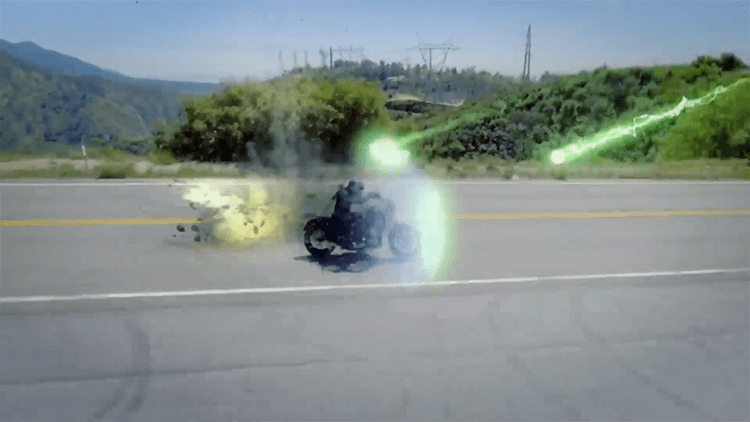

Shots from the motorcycle chase before and after CGI was added
It was a hot and sunny day, so I had to use the hood to see my iPad—because of the brightness I used an ND16 filter with polarizer. It was initially a challenge to wait for his motorcycle to enter the shot and continue to keep up with him, so I flew in sport mode in some shots, making sure to keep the props out of the frame.
There were lots of curves in the road we were shooting on, with shrubs sticking out, just asking to be flown into.
We were shooting in the Angeles National Mountains—the spot they originally wanted to use was inside a National Park and thus a NFZ (no fly zone). But we were able to quickly look at a sectional chart and also Google Earth, and find a suitable area that the director liked. I always come early to a shoot so I can scout the area, get the bird up in the sky, and test out what settings and gear work best beforehand.
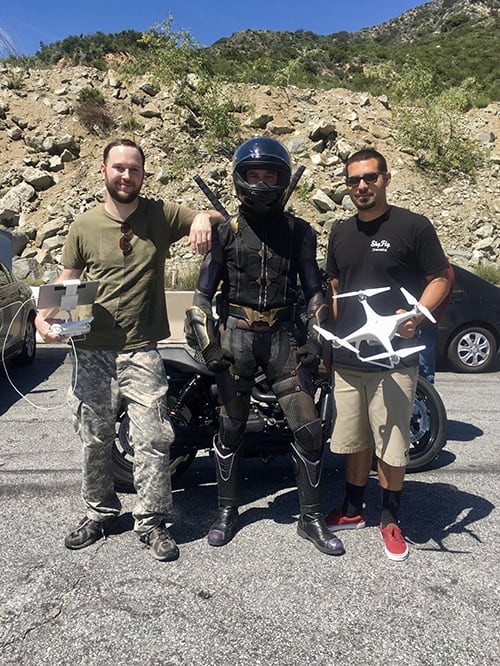

Ryan (left), the stuntman (center), and visual observer / friend Rio Scott (right)
Tell us about your gear. What drone(s) do you fly, what cameras do you use, and do you recommend any other accessories?
On a normal day I make it a point to fly regardless of whether I have to work that day. Keeping your hand / eye coordination strong is important, so zipping around the block with small drones like a Hubsan, or indoors with even smaller nano drones is a great practice.
The camera I use really depends on what I need to accomplish for the client or my own personal work.
Most of the shoots I do require one of my Phantom 4 Pro units. I like that it has some weight to it compared to the Mavic series, which seems to help it hold up in high winds much better with less “jello” effects. Certain clients require me to fly an Inspire, and others want even bigger and badder machinery, like a Matrice or Spreading Wings.
Using the right filters is important as well. I use PolarPro as they are quality and they have great customer service. (Shoutout to Jeff Overall for the free gear over the years!)
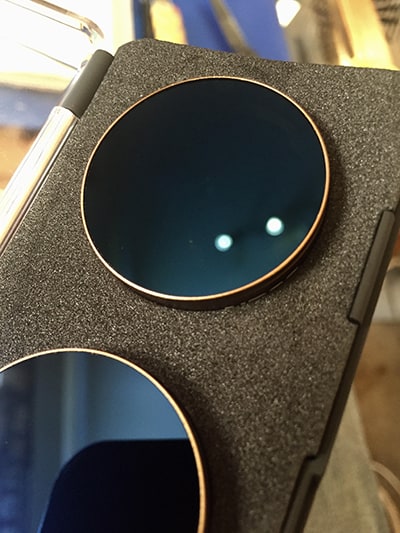

A shot of Ryan’s filters that he shared with us
If I’m not doing aerial shots for a client, I find that my OSMO X5R does an exceptional job for steady shooting. At 24fps and in full 4K, the footage always turns out great. I can maneuver between people and obstacles with ease, making the footage look very clean and impressive.
I like to use the external battery adapter with a Phantom 4 battery, as the little ones that go inside the handle run out far too quickly.
And don’t forget that a GoPro can sometimes do what other cameras cannot. I have done quite a bit of beta testing for the company, and have helped them develop and design various mounts (and occasionally firmware).
What are your predictions for aerial cinematography, and the drone industry in general?
Currently, airspace regulations don’t make getting approval to fly very easy, even when you have your commercial certification.
There are far too many cities that may appear to be class G airspace, but then have their own local ordinances. Many require you to pay a yearly fee and use a big dumb sticker on your drone when flying there.
Hermosa Beach here in California is a perfect example. I’ve had a few instances where lifeguards and / or police have been quick to interrupt a commercial shoot. Many times, they will be cool and perhaps even interested in how the UAV operates, but other times, you’ll find that they believe their local authority outweighs your federally issued commercial license.
It’s important not to make them feel like you aren’t cooperating, so explaining and showing them a sectional chart is helpful. Even then, I’ve had police threaten to arrest me. Just make sure to hold your ground until a superior comes along with the correct knowledge. Then you can go about your shoot without interruption.
I believe as the UAV industry continues to expand, people will come to understand that we are pilots navigating in shared airspace. One good thing to practice is calling ATC and getting used to asking for permission to fly on a certain day, at a certain altitude and location.
Even after obtaining permission to fly in, lets say Class D airspace, you then have to wait on DJI for a number of days before they will give you the “code” to deactivate the GEO zone you will be flying in. I hope to see that become more simplified in the future, because it’s a real hassle.
On a separate note, I am very interested to see how automated drone delivery, like what Amazon is working on, will affect our ability to get flight authorizations—just think about how many UAVs will be cruising around the skies if deliveries start happening on scale.
It’s an exciting age to be living in, and definitely a lucrative and awesome industry to be working in!
Check out this promo poster for Ninjak vs. the Valiant Universe below, and watch an episode of the show here.
